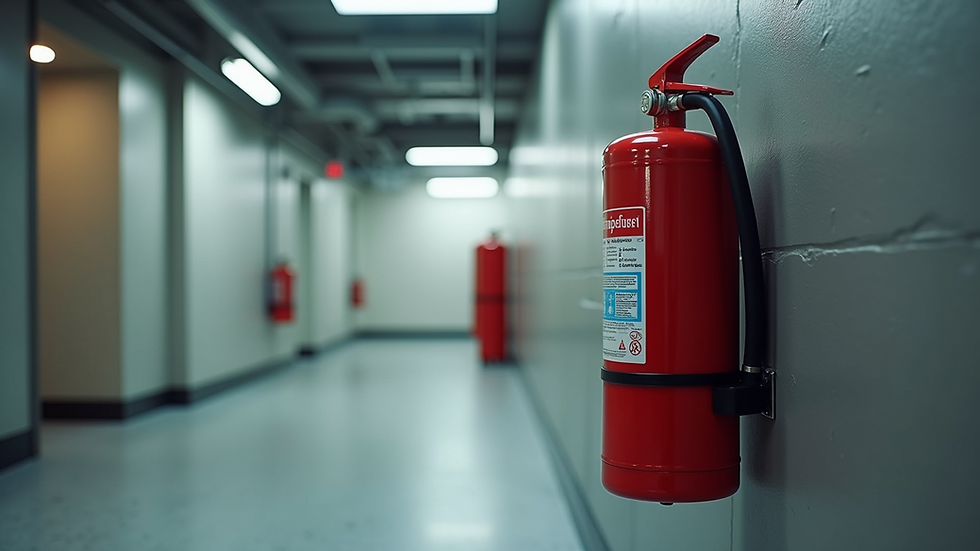Understanding Fire Risk Assessments
- Five Henry Risk Management Services Ltd

- Aug 3
- 4 min read
Updated: Sep 3
Fire safety is a critical aspect of any building's management and operation. Understanding fire risk evaluations is essential for ensuring the safety of occupants, protecting property, and complying with legal requirements. This article explores the key elements of fire risk evaluations, their importance, and practical steps to conduct them effectively.
What Are Fire Risk Evaluations?
Fire risk evaluations are systematic processes used to identify potential fire hazards within a building or premises. They assess the likelihood of a fire occurring and the potential impact it could have on people and property. The goal is to reduce fire risks to an acceptable level by implementing appropriate control measures.
These evaluations involve examining various factors such as:
Sources of ignition (e.g., electrical equipment, open flames)
Flammable materials present
Building layout and escape routes
Fire detection and suppression systems
Staff training and emergency procedures
By thoroughly assessing these elements, organisations can develop strategies to prevent fires and ensure safe evacuation if a fire does occur.

The Importance of Fire Risk Evaluations
Fire risk evaluations are not just a regulatory requirement; they are a vital part of maintaining a safe environment. Here are some reasons why they are important:
Protecting Lives: The primary purpose is to safeguard the lives of employees, visitors, and residents by identifying and mitigating fire hazards.
Legal Compliance: Many countries have laws mandating regular fire risk evaluations. Failure to comply can result in fines or legal action.
Minimising Property Damage: Early identification of risks helps prevent fires that could cause extensive damage to buildings and assets.
Reducing Business Disruption: Fires can halt operations for extended periods. Effective fire risk evaluations help maintain business continuity.
Insurance Benefits: Insurers often require evidence of fire risk evaluations to provide coverage or reduce premiums.
Organisations that prioritise fire safety demonstrate responsibility and care, which can enhance their reputation and trustworthiness.

When Should a Fire Risk Assessment Be Performed?
Knowing when to conduct a fire risk assessment is crucial for maintaining ongoing safety. Here are the key times when an evaluation should be performed:
Before Occupying a New Building: Conduct an initial assessment to identify any existing fire hazards.
After Significant Changes: If there are alterations to the building structure, layout, or use, a new evaluation is necessary.
Following a Fire Incident: After any fire or near-miss, reassess risks to prevent recurrence.
Regular Intervals: Many regulations require periodic reviews, often annually or biannually.
When New Equipment or Processes Are Introduced: New machinery or operational changes can introduce new fire risks.
Regular assessments ensure that fire safety measures remain effective and up to date.

How to Conduct Effective Fire Risk Evaluations
Conducting a thorough fire risk evaluation involves several practical steps:
1. Identify Fire Hazards
Look for potential sources of ignition, fuel, and oxygen. Examples include:
Electrical faults or overloaded sockets
Flammable liquids and gases
Waste materials like paper or packaging
Cooking equipment
2. Identify People at Risk
Consider who might be affected by a fire, including:
Employees and visitors
People with disabilities or mobility issues
Contractors or temporary workers
3. Evaluate, Remove, Reduce, and Protect
Evaluate the risks and decide on necessary actions.
Remove unnecessary fire hazards.
Reduce risks by implementing control measures.
Protect people by ensuring safe escape routes and fire safety equipment.
4. Record Findings and Prepare an Action Plan
Document the risks identified and the measures taken. Create a clear plan for addressing any outstanding issues.
5. Review and Update Regularly
Fire risk evaluations are not one-time tasks. Regular reviews ensure ongoing safety.
Practical Tips
Use checklists to ensure no area is overlooked.
Involve staff in identifying risks and improving safety.
Train employees on fire prevention and emergency procedures.
Maintain fire safety equipment regularly.
The Role of Professional Fire Risk Assessors
While some organisations may conduct their own evaluations, hiring a professional fire risk assessor can provide several benefits:
Expertise: Professionals have specialised knowledge of fire safety regulations and best practices.
Objectivity: An external assessor can provide an unbiased view of risks.
Comprehensive Reports: Detailed documentation helps with compliance and insurance.
Tailored Recommendations: Advice specific to the building and its use.
For those seeking expert assistance, a fire risk assessment service can offer valuable support in managing fire safety effectively.
Enhancing Fire Safety Beyond Evaluations
Fire risk evaluations are the foundation of fire safety, but ongoing efforts are essential to maintain a safe environment:
Regular Fire Drills: Practice evacuation procedures to ensure everyone knows what to do.
Maintenance of Fire Equipment: Check extinguishers, alarms, and sprinklers frequently.
Clear Signage: Ensure escape routes and fire exits are clearly marked and unobstructed.
Staff Training: Educate employees on fire hazards and response actions.
Emergency Planning: Develop and communicate a comprehensive fire emergency plan.
By integrating these practices, organisations can create a culture of safety that minimises fire risks.
Understanding fire risk evaluations is vital for protecting lives and property. By identifying hazards, assessing risks, and implementing control measures, organisations can create safer environments and comply with legal requirements. Whether conducting evaluations internally or with professional help, regular attention to fire safety is a responsibility that should never be overlooked.



Comments